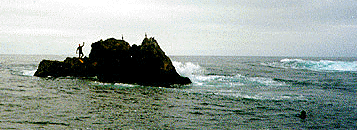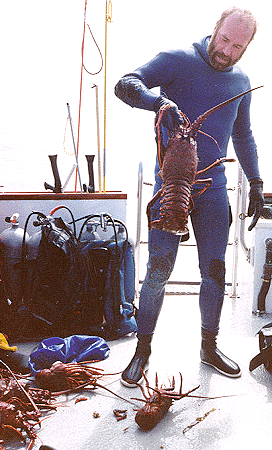
CopyRight @ 1997
San Nicolas is a flat island, about 8 miles by 3. It is the farthest out of the California Channel Islands. You can land a fair sized jet on it though.
The island is directly exposed to
weather from all directions. By dive boat it is generally a six hour
trip there from the docks at Los Angeles, Ventura or even Santa
Barbara. Middle of no where in the middle of everywhere.
Being exposed and remote like this has reduced diver pressure and even
commercial harvesting of the island. So has the Navy with its closures.
What makes this such a healthy and abundant reef system though is largely
its sheer size. The shore around the island drops off very slowly and it
may only be 100 feet deep a few miles offshore on the west end. These
miles of rolling, rock reefs offer a huge area for divers to explore and
almost endless niches for sea life to make their homes.
This is a place where the Giant Black Sea Bass was able to avoid hunters
until they were finally protected and this is where they have recovered
enough to be fairly common sights for divers.

The diving on the island breaks up into a few different characteristic areas, each with diving typical to the area. These pretty much follow the directions of the compass.
The East End is the smallest side of the island and there is really very little diving on that end because it is a large sandbar that extends miles beyond the end of the island. Out near the end of that though is another reef that can only be visited in days with very calm currents.
The northern Frontside extends for about 8 miles and represents reefs
that gently slope to a depth way deeper than you want to go. The reefs
structure is generally rock and sand bands parallel to the island shore.
A diver can swim in or out from the island and find a band of rock that
looks like it is worth following. After half their tank, they can go in
or out to another band and head back towards their boat. Bands may be 5
feet wide or 100. They will be made of different kinds and sizes of rocks,
with varying amounts of sand channels between the rocks. The bigger the
rocks, the more hidey holes for critters to live in and the more for the
diver to see. In the areas where there are larger sand channels between
the rocks, halibut are often hidden. Much of the bottom
there are large flat sheets of rock. At there edges can be ledges of every
size. A ledge may only stick up a few inches at the back, but there might
be a 12 inch crack at the front that extends back 10 feet. Some of these
ledges are huge and offer some of the best diving. Even on the
rock slab, a close look reveals small urchins, crabs and other creatures
that carry their protection with them. There are small holes and cracks
that make an infinite number of small habitats in which critters make
their homes.
The entire Frontside can be great for lobster hunting. It can be
deep or it can be great right in the tide pools on shore.
Game fish of all kinds can be found here. Halibut, large Calico Bass,
Yellowtail, Sheepheads and numerous kinds of rockfish are common. There
are far more than that to see, including the occasional Black Sea Bass.
The big ones are unmistakable and the smaller ones look like the biggest
Calico Bass you ever dreamed of seeing.
One thing I haven't figured out is about the abalone. The area seems like
it would be very good for finding large red abalones, but that is not the
case. I have only seen a handful of abalone there and have only seen a few
taken. Now they were all huge and of what I have seen there, the majority
(say 4) were over 10 inchers... The one that I found on the West End was
also 10 inches. I have to wonder at this scarcity. Is it because of
harvesting or is there just something about the habitat that abalone don't
like.
Before the shrinking foot disease came along, I saw hundreds of
large black abalone right along the shoreline.
The southern Backside is also a miles long area where the diving is
rather similar. Again, the reefs slope slowly from the shore with vast kelp
beds more than a mile off the shore that are only perhaps 60 feet deep.
This is abalone country. It has been heavily harvested, but the habitat
seems so good that the commercial abalone harvesters just weren't able to
get them all.
Back here, towards the south end of the island, is Frenchy's Cove.
This is one of the few vaguely sheltered areas on the island and is where
the dive boats tend to park for the night. When it gets dark and still, you
can hear the Elephant Seals barking on the shore.
There are lobsters on this side of the island, even occasional big ones I
can say, but it is not the best place for hunting them.
It is the West End of the island that has given much of the
reputation for both advanced diving and abundant game to San Nicolas Island.
This is where the Badlands is and the Boilers. Everything here seems
enlarged. The fish are just bigger and so are the lobsters. Even the rocks
and the kelp seem oversized in this vast divable area.
The Badlands, also referred to as the
Freeway and the Flats is a huge area of mostly flat rock
reef covering much of the area off the West End. It tends to be somewhat
deep, much of it in the area of 70 or 80 feet. Of course, it extends way
down deeper. It is wide open, exotic diving and there can be a lot of
lobsters there, with no place to hide. In the 80's, if a diver went there
and swam as fast as they could, they were likely to come across lobsters
in the 7 pound range and might well encounter a 10 pounder.
The Boilers also referred to as Bull City in years back, is a large reef that sticks up to the surface a couple of miles off the West End. It is a place of open ocean waves breaking on sharp rocks, creating a constant boil of white water. It creates a large, shallow divable area just under the waves breaking above the reef. It is a challenging, beautiful dive with thick lush life competing in the rich currents. If you get really lucky, you might even find one of the Bull Lobsters still there.

The other main dive area of note at San Nicolas is Begg Rock. This reef that sticks up 8 miles to the west of the island, is the basalt crystal heart that is all that remains of an ancient volcano. The main reef of Begg Rock sticks up about 15 feet above the water, though there are some other associated pinnacles and wash rocks nearby. The reefs tend to have vertical sides until there are some ledges at 40 feet and occasional ledges on deeper. It offers exceptional photo opportunities of Corynactis and Metridium anemones as well as myriads of other colorful filter feeders that thrive in the currents. Also, unlike the island, there are abundant big scallops well stuck to the rock also. Begg rock is an exotic dive that is often listed as a dive boat destination, but far less often reached.
Deep down, way off shore, sometimes you can find creek beds from another time.
It is incredible to be relaxing between dives when a huge, 4 engine, P-3 Orion submarine hunter aircraft flys by just overhead.
The Navy owns the island and has invested greatly in it, primarily for anti-submarine warfare, or so they tell you that that is what it is for... In the center of the island is a large air base. You will almost never see any activity on the island, but it is a busy naval base. Legally, you are never supposed to go closer to the island than 100 yards. This is no joke. Sometimes, the island or parts of it may be closed for testing. In the little coves that are sheltered from the island, are small radar units. Big brother is watching there.
Some old guy once told me he was fishing many years ago and caught a 20 pound lobster on his line. An unlikely story, but he said that he had been in the navy at the time and was stationed at San Nic. I was then inclined to wonder more about how big the bug really was, rather than if he really caught it. At San Nic, the whopper may be what you really caught, not just the story you told.
To a lot of divers, San Nic means big bugs. Some people got the meaning better than others. Shel and Wayno got the message the best. I call Wayno the best lobster hunter of the 80's and Shel the best of the 90's. Few people have ever much disagreed. here are a few pictures that show why.




Then there is Bill Magee, the owner of the Peace was not only skilled, but incredibly lucky.
